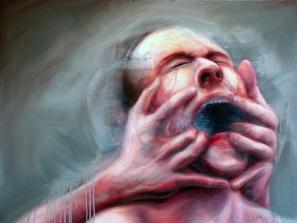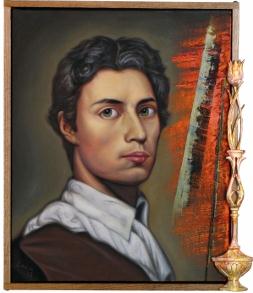
Self-portrait on Green Ground. Credit: Mathieu Laca
Montreal artist Mathieu Laca is a unique voice in Canadian art. Strong in homoerotic and symbolic content, his work echoes the reality of how I experience life through the mind: a jungle, beautiful and wild, scary and scattered, surreal and full of symbols I try to decipher and often fail to grasp — the more basic, banal and truly bestial nature of myself, an animal; myself an intellectual hungry for meaning; myself emotional, reacting with disgust, fear and sometimes, very rarely, with abandon and laughter.
Laca is represented in Ottawa by Patrick John Mills Contemporary Fine Art Gallery, where he held an exhibition, titled Porn Is Not Art, last year. His latest work will be shown at the gallery as part of a group exhibition, Naked! Naked! Naked!, from June 1 to 30; Laca will attend the vernissage. He will return to the gallery this fall for another solo exhibition, tentatively titled Balls to the Wall, from Nov 1 to 30.
His latest body of work includes the painting Thanksgiving, which sparked an intensely visceral and emotional reaction in me. It is reminiscent of the feasting paintings in medieval and Renaissance art, such as Bartolomé Esteban Murillo’s The Marriage Feast at Cana, the more explicit Feast of Herod by Lucas Cranach the Elder, or the animals featured in Joachim Beuckelaer’s The Well-Stocked Kitchen.
Even as Laca’s work and themes are contemporary, he seems to carry a long tradition of food-related and animal painting.
To gain a better understanding of Laca’s work, process and philosophy, I recently asked him a few questions.
Your work is very symbolic and uses a lot of imagery — archetypes in the Jungian sense. In the painting Thanksgiving, we have blood, animal heads on human bodies, body parts cut off — these seem to be recurring themes in your body of work. What do they mean to you?
I want to paint works that make a strong impact. That’s why I charge them with such heavy symbols. As to what they mean exactly, I can hardly tell. And in fact, it’s more or less important because paintings have a visual meaning, not a literary one. But I can tell you this: when I paint, I’m very receptive to the unexpected. Very little is planned, and I make decisions solely based on what excites me at the precise moment. I can start to paint a simple two-headed figure and then decide to chop the two heads if it seems right to do so. Painting is very much like gambling. At every point, you have to be willing to lose everything for a fresh new gain.
You often talk about the relationship between desire and violence, and I’d like to understand your philosophy of these two concepts that are closely related for you. Why is desire necessarily violent, and if their relationship is thus linear, does that mean that to be without desire means to be nonviolent?
Desire and violence are closely linked. Maybe they are two sides of the same thing after all. Some people are repelled by a so-called violence in my work. The thing is, I don’t see it as violence. The word violence bears a moral judgment. I see it more as intensity. If there is violence, it’s not a real violence but rather a violence that occurs in the mind of the viewer, triggered by my use of “strong symbols” that you pointed out. It’s a violence that takes place on the imaginary level. Just like the violence we find in Greek tragedies or tales. Not the “Disneyfied” tales, though; I mean the genuine tales like those of the Grimm brothers, where Cinderella’s sisters cut their toes to fit the shoe.
Back to the theme of sexuality, which seems central to your work: you’ve said in the past that erections can be powerful ammunition and a strong expressive symbol. Can you develop this a little further and explain how your use of erections as symbol has evolved over the years?
Michel Houellebecq, in his novel Plateforme, writes that every war could be understood as a battle to possess the vaginas of the opponent’s young women. That’s a very strong thought. It underlines how sexuality is important in human behaviour and human history. Yet, we find almost no artworks showing erect penises in the Western world after the ancient Romans. Why? The Christian disease that still endures today even in art. To take pleasure in the sight of an erect penis is still very subversive in the high world of painting, a world shaped by centuries of white, Christian, European, heterosexual gaze. So, to choose to ignore that taboo and to work only from your personal inclinations like I do often creates quite a stir.
I’m interested in your frames. I understand you make your own. Why and how do they interact with your paintings?
I’m very bound to tradition. I used to grind all my colours, and I recently did a series of portraits of old masters using only the pigments those painters were using in their time. Framing is part of that general process, but it’s entirely the work of my dear husband, Jean. He carves wonderful traditional patterns in wood and gilds them with gold leaf. He then fixes them on very modern-looking shadow-box frames, which creates the same contrast I pursue in painting between a traditional and a more contemporary approach. So, the frames are inseparable from the works. Each one is made by hand for a specific painting and echoes its formal features. I am so blessed to work with him every day in our studio. It’s a great joy.
Mathieu Laca
Naked! Naked! Naked!
Fri, June 1–Sat, June 30
Vernissage: Thurs, June 7, 6–9pm
Patrick John Mills Contemporary Fine Art Gallery
286 Hinchey Ave, Ottawa
patrickjohnmills.com

 Why you can trust Xtra
Why you can trust Xtra


